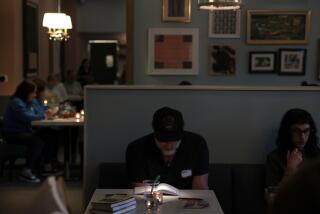From Our Blogs
- Share via
Religious edicts are generally not fodder for beauty salon gossip, but as soon as Shiite cleric Ayatollah Mohammad Fadlallah issued a fatwa allowing women to pray wearing nail polish, word spread through Beirut faster than knockoff Prada bags.
“All the girls in the Dahiyeh are talking about it,” said 29-year-old Nadine Dirani, a veiled mother of two living in the Dahiyeh, Beirut’s heavily Shiite southern suburbs.
“I think it’s an important step, and why not?” she said. “It makes our lives easier.”
Fadlallah, the cleric accused by the U.S. of ordering a series of terrorist attacks in the 1980s, is known for issuing unconventional fatwas, some of which have provoked criticism from conservative corners.
He recently ruled that women are allowed to strike their husbands in self defense, and that all seafood is halal, or permitted, a first for a decree by a Shiite cleric.
The nail polish fatwa came in response to a question from a female supporter and was later posted on Fadlallah’s official website.
The logic behind the previous ban was not tied to modesty so much as nail polish was considered a barrier to the skin that prevents proper ritual ablution before prayers.
The wording of the new fatwa makes it clear that the thick, removable barriers such as “dough, henna grease and the like,” which invalidate the “wudou,” or ablution before prayers, do not include “the thin barrier that tightly sticks to the body.”
Therefore, small amounts of substances such as “paint and glue” are permissible, the decree said.
-- Meris Lutz in Beirut
From: Babylon & Beyond: Observations from Iraq, Iran, Israel, the Arab world and beyond
For more, go to latimes.com/babylon
--
BOOSTER SHOTS
Reducing Latino diabetes risk
Small changes can often yield big results, health experts have been saying for years, and here’s more proof: By slightly reducing sugar and increasing fiber, Latino teenagers may lessen some risk factors linked with Type 2 diabetes.
Latino teens (average age 15) were part of a study looking at the effect minor dietary and activity changes over 16 weeks had on their metabolism and body composition.
Of the 54 Los Angeles County teens who participated, some were assigned to a nutrition group, attending one nutrition class a week; some were assigned to a nutrition and strength training group, taking one nutrition class per week and doing two strength training classes per week; and others were in a control group that received no health-related interventions. The goals of the nutrition classes were to get the teens to decrease added sugar and increase fiber consumption.
Researchers found that 55% of all participants cut their sugar consumption by 47 grams per day -- the equivalent of one can of soda -- and 59% of all teens upped their fiber by an average of 5 grams a day -- the amount in about half a can of beans. That decreased sugar intake accounted for an average 33% decrease in insulin secretion. More fiber resulted in an average 10% less visceral fat, which is known to increase the risk of diseases such as diabetes.
And yes, that was all participants -- even the ones in the control group. Researchers believe they might have made the dietary changes because they knew the purpose of the study and may have been more motivated to make changes.
The authors cited other research that found Latino children are more insulin resistant than white children, making them more likely to develop chronic diseases linked to obesity. In the study, they wrote: “Modest changes in sugar and fiber consumption . . . could lead to substantial improvements in adiposity and metabolic parameters. Furthermore, given that the control group demonstrated similar dietary changes as the intervention groups, our results suggest that intensive interventions may not be necessary to achieve modifications in sugar and fiber intake.”
The study, conducted by researchers at the Keck School of Medicine at USC and the L.A. County-USC Medical Center, appears in the April issue of Archives of Pediatrics & Adolescent Medicine.
-- Jeannine Stein
From: Booster Shots: Oddities, musings and news from the world of health
For more, go to latimes.com/boostershots
--
TECHNOLOGY
The blind protest over new Kindle
The Reading Rights Coalition, a group that says it represents disabled readers, staged a protest last week outside of the Authors Guild’s New York offices.
Its complaint: The guild’s objection to the read-aloud feature of Amazon’s Kindle 2 electronic book harms people with disabilities.
In February, the guild complained about the Kindle 2’s text-to-speech function, which uses an electronic voice to recite text. The organization said then that the feature “presents a significant challenge to the publishing industry,” suggesting that it could hurt the $1-billion market for audio books. Amazon, which introduced the second-generation Kindle in February, later backed off and said it would allow authors to disable the feature for their own titles.
Though that may have mollified some writers, it incensed another group of constituents -- people who can’t read print because they are blind or learning disabled. The Reading Rights Coalition, whose members include the National Federation for the Blind and International Dyslexia Assn., maintains that the read-aloud feature should be available for all Kindle titles, which currently include more than 260,000 books and several dozen newspapers, including The Times.
The group organized the rally, with protesters chanting such slogans as, “No need for greed, we want to read.”
The guild issued a statement to the Associated Press, saying that the protest was “unfortunate and unnecessary.” It did not return calls seeking further comment.
-- Alex Pham
From: Technology: The business and culture of our digital lives
For more, go to latimes.com/technology
More to Read
Sign up for Essential California
The most important California stories and recommendations in your inbox every morning.
You may occasionally receive promotional content from the Los Angeles Times.










